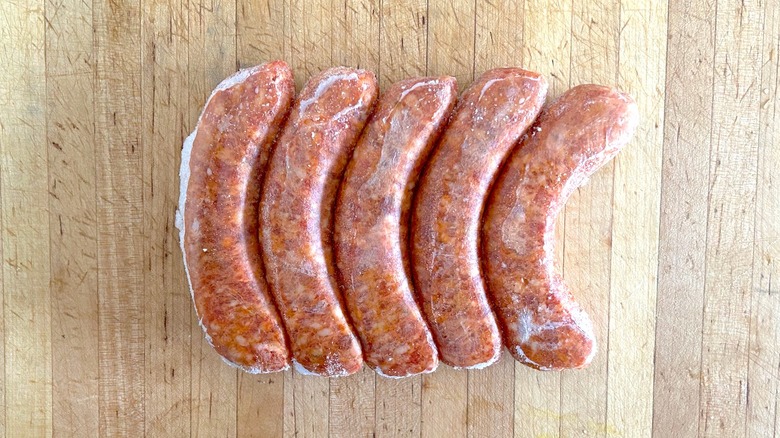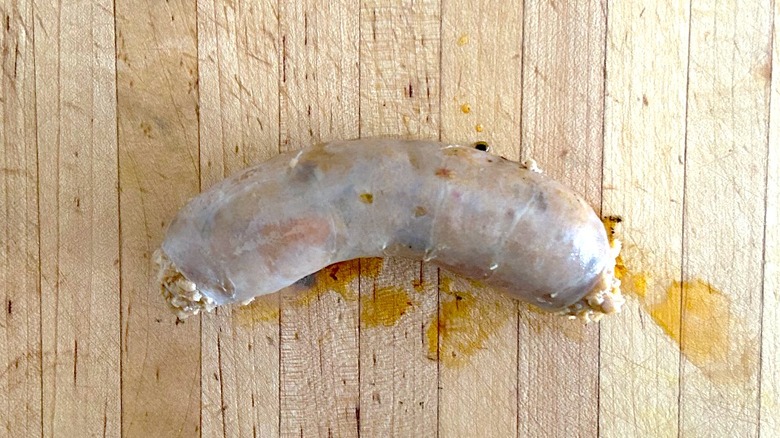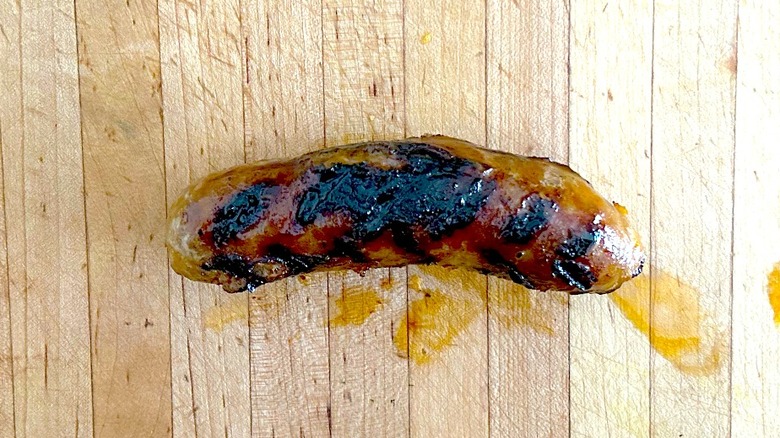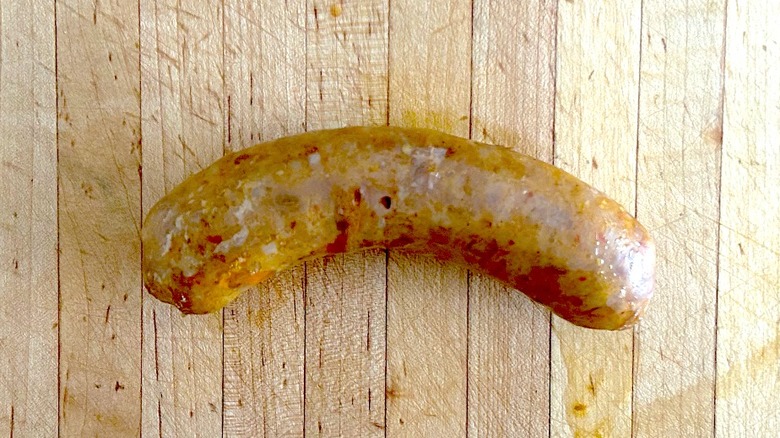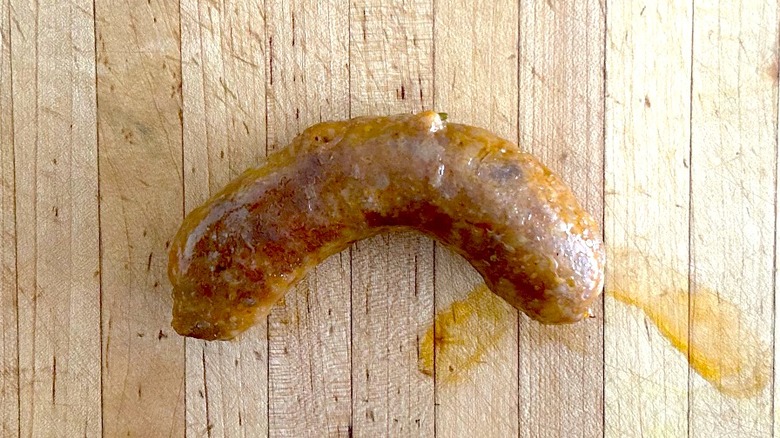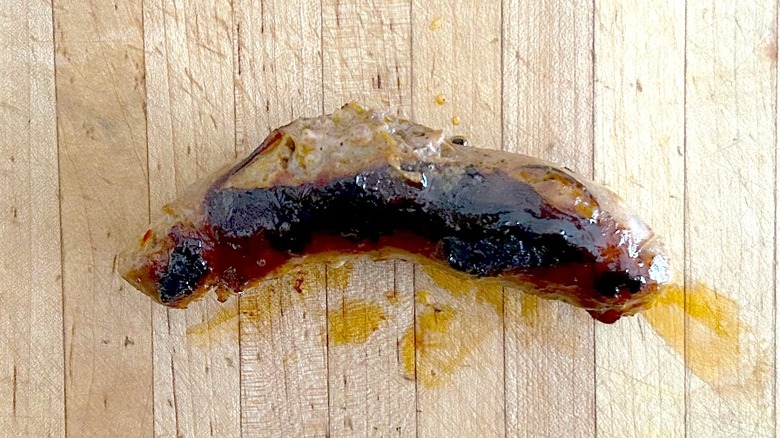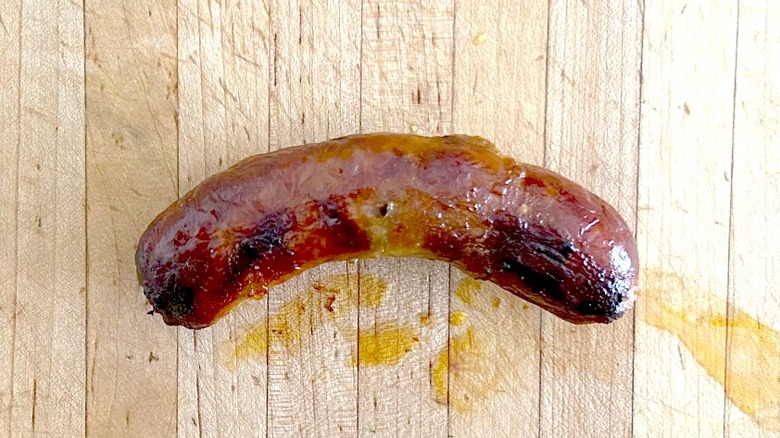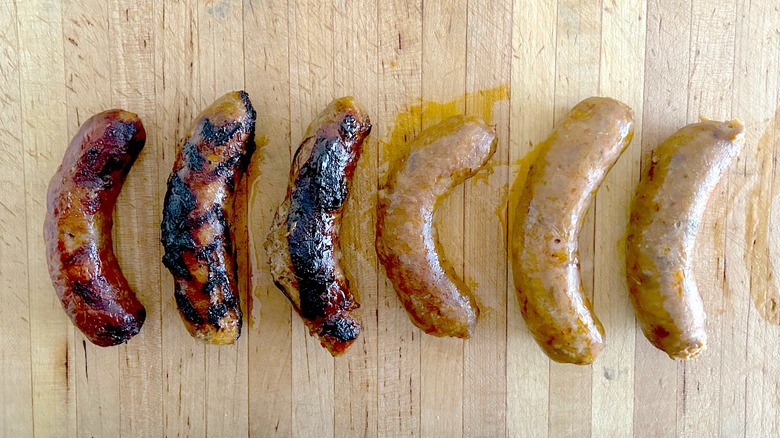We Tried 6 Methods For Cooking Frozen Sausage And This One Was The Best
Suppose your preferred big box store is having a blowout sale on your favorite Italian sausages, and you decide you might as well stock up. Now, let's pretend you have guests show up unannounced, and you suddenly find yourself scouring your freezer for something quick to whip up to serve them for a simple lunch or dinner. You remember those sausages you purchased for precisely this occasion that have been waiting for their time to shine, but you don't have time to thaw them. Now what?
Believe it or not, you can safely and successfully cook sausages from frozen. Per the USDA, uncooked sausages can be frozen for up to two months. Beef, pork, and lamb sausages must be brought to a safe minimum internal temperature of 160 degrees Fahrenheit, and chicken or turkey ones should reach 165 degrees. Knowing this, what's the best way to quickly prepare these frozen sausages to stay moist, cook through, and have a crisp skin?
That's where I come in. As a chef with 18 years of experience, I've cooked a fair number of sausages from around the world. I decided to put six popular methods for cooking sausage to the test. I used uncooked pork sausages straight from the freezer and transferred them to their respective cooking vessels. I'll describe more about the methodology I used to test these different techniques at the end of this ranking. For now, here's which method for cooking frozen sausage reigned supreme and why.
6. Poach
Among the many sausage cooking hacks that we should all add to our culinary arsenal is the process of poaching them in water, stock, or beer. This technique is usually paired with grilling, but you can boil a hot dog and place it straight onto a toasted bun. Using this as inspiration, I put a frozen sausage straight into simmering water. In this case, I didn't use a full rolling boil because I was concerned the sausage would explode if I did so. Poaching in simmering water is a more delicate approach that will gently heat the inside of the sausage without putting too much pressure on the casing.
The sausage took roughly 20 minutes to reach an internal temperature of 160 degrees Fahrenheit. After removing it from the water and draining it on paper towels, I cut it into the center to ensure it was cooked. While it was, the exterior was very pale, with the skin turning out somewhat leathery and chewy. I also noticed the sausage seemed to have a muted flavor compared with all the others I sampled, likely due to the seasoning and fat leaching out into the cooking liquid. What I did appreciate was that the center of the sausage retained a juicy texture that was not grainy. Though this sausage was perfectly edible, it would have benefited from a brief stint on the grill to help it crisp up on the outside. For this reason, I ranked it last on my list.
5. Grill
I hesitated over where to rank this method. While I enjoy the smoky flavor from the charring you obtain on the exterior of a sausage cooked on the grill, getting the center to cook evenly can be challenging. I used an inside stovetop grill pan versus an outside grill, but the results would be similar.
The sausage took roughly 15 minutes to cook, rotating every few minutes, before the thermometer registered 160 degrees Fahrenheit. That said, the very center was still slightly pink, so I was personally uncomfortable with eating it. I might have left it on the grill longer, but the exterior was getting overly blackened, and the sausage had begun to burst open, so I took it off at that point.
When I sampled the sausage, the skin had a lovely taste and a good snap that was easy to cut into. The flavor of the part of the sausage that appeared fully cooked through was good, but the center was just a touch grainy and perhaps a bit drier than some of the others I had made. That said, this would be a suitable method used in conjunction with poaching for frozen sausage. The center would be cooked through and moist, and the smoky char from the grill would help impart some much-needed flavor from what gets lost in the poaching liquid.
4. Oven
While the oven and the microwave were almost tied, I decided to rank the former below the latter because it takes much longer. After pre-heating to 350 degrees Fahrenheit, I placed the sausage on a baking dish and popped it in the oven. The frozen sausage took 35 minutes to reach 160 degrees Fahrenheit, rotating the sausage every 10 minutes or so. The pro to this method is that it requires little to no effort or focus. You can put the sausage in the oven and ignore it except occasionally turning it. The con is how long it takes to attain similar results to the microwave.
The cooked sausage was marginally more crisp on the exterior than with poaching or microwaving, but not by much. I expected it to be more browned than it was, which was disappointing. This is likely because it gets steamed from the inside, inhibiting the Maillard reaction from occurring. It was still a bit chewy and lacked the snap that is so desirable in a sausage.
The center was fully cooked and quite moist, and the flavor was more robust than the poached sausage, though it lacked the smoky notes of the grilled one. The center was just a touch grainy, but this wasn't a deal breaker. Overall, this is a solid method for cooking a frozen sausage if you need to focus on other dishes and aren't in a hurry.
3. Microwave
I tend to be a microwave snob, reserving it for leftovers and popcorn and never using it to cook anything. That said, I understand that when you are in a pinch, it can be effective even if it can leave things lacking in flavor and texture. In this case, I was pleasantly surprised at how well the microwave worked for cooking a frozen sausage.
A cooking thermometer is necessary to ensure you cook your sausage to a minimum safe internal temperature in the microwave. Microwaves can cook unevenly, and it's challenging to determine doneness by simply looking at or touching meat cooked in one. I put the frozen sausage in a microwave-safe bowl, covered it with a paper towel to avoid splatter, and cooked it in 30-second increments, turning it at every interval. It took two minutes for the sausage to reach 160 degrees Fahrenheit.
Initially, I thought the sausage would turn out floppy and the skin chewy, because it didn't crisp up and began to pull away from the meat. I was also concerned the sausage would end up quite dry because a lot of grease leached out into the bowl. While the skin wasn't crisp, it was firm and sliced well, while the center remained moist and had great flavor. Because some of the grease had melted out, I could taste the meat rather than the fat — a welcome change of pace. All things considered, if time is your primary consideration, this method cannot be beaten.
2. Pan-Frying
I anticipated pan-frying would be a winning method, and I was not disappointed. This is a consistent and user-friendly cooking technique that doesn't require any special equipment, just some time and attention. I began with a nonstick cooking pan and placed the frozen sausage directly into it without any oil. I heated the pan over medium-high heat to get it going, then reduced the temperature to medium once the meat started sizzling.
I let the sausage cook uncovered for about five minutes before turning it over. After another couple of minutes, I covered the pan, using the frozen interior of the sausage to create steam under the lid to help cook the meat more evenly. After another couple of minutes, the sausage was thawed enough to rotate it onto its edge to help cook the exterior more evenly. I flipped the sausage onto its final side during the last five minutes of cooking. It reached 160 degrees Fahrenheit at around the 20-minute mark.
The one disadvantage to pan-searing a frozen sausage is that the skin is fragile and tends to tear, causing it to explode and the meat to ooze out. This makes it less visually appealing, but the technique does yield good results overall. The sausage remains moist on the interior while the exterior is browned. The meat is flavorful, but the lack of a good snap makes it less texturally appealing than the top method, which is why I ranked it second.
1. Air Fryer
This is the second time recently that I've been surprised at how effective an air fryer is in cooking something. I'm always skeptical of the latest kitchen gadgets, wary of how much might just be hype. After using a borrowed unit, though, I've decided it's worth the investment to purchase one of my own. Air fryers work by circulating air around the food within the unit, helping to crisp it up without the need for excessive amounts of oil. This means a crisp exterior, moist interior, and shorter cooking times for many foods.
To cook a frozen sausage in the air fryer, I placed the meat in the unit and set it to 350 degrees for 10 minutes. After rotating the sausage, I cooked it 5 minutes longer at 350 degrees. After 15 minutes, the center registered at 160 degrees Fahrenheit on a meat thermometer and had a beautiful golden crispy skin.
The finished sausage was nothing short of perfection. Its skin had a nice snap and a hint of crunch, and the center was evenly cooked and remained moist. The sausage did lose a bit of volume, but it was smooth, not grainy, and had a delectable umami-rich flavor that wasn't greasy. Lastly, the sausage did not escape its casing, retaining its shape perfectly. Overall, for speed, quality, and efficacy, the air fryer is a home run for cooking a frozen sausage link.
Methodology
This experiment was conducted using Johnsonville Hot Italian Sausage links. In my professional opinion, I believe the results would be similar to using any other kind of uncooked sausage with a natural casing. I didn't use oil in any of the cooking methods, allowing the fat from the sausage to keep it from adhering to the pan, grill, or air fryer. I also used an instant-read meat thermometer to test the internal temperature of the sausages with every method tested.
While I didn't thaw the sausages at all, I did allow them to sit at room temperature for about five minutes before cooking them, as I couldn't separate them from one another straight out of the freezer. Lastly, I allowed the sausages to rest for three minutes after removing them from their respective cooking vessels per USDA guidelines.
My overall impressions were based on several factors, including ease, length of time, and amount of attention required to use a cooking method. In terms of the sausage itself, I was most concerned with the texture of the skin, uniformity of doneness of the interior, inherent moistness of the meat, and quality of flavor. The final ranking reflects my preferences for a juicy sausage with crisp, snappy skin and a meaty flavor that doesn't leave a greasy film in your mouth.
